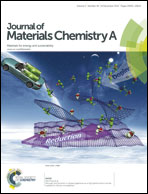ECTFE porous membranes with conveniently controlled microstructures for vacuum membrane distillation
Abstract
Poly(ethylene chlorotrifluoroethylene) (ECTFE) microporous membranes were prepared via a thermally induced phase separation (TIPS) process using a mixed diluent of bis(2-ethylhexyl) adipate (DEHA) and diethyl phthalate (DEP). The formation mechanism of ECTFE membranes was proposed with the assistance of a pseudo-binary temperature-DEHA ratio phase diagram of the ECTFE-diluent mixture system. The morphologies of the prepared membranes were observed by using a scanning electron microscope (SEM) and an atomic force microscope (AFM). The membranes' corresponding distillation performances were characterized in terms of porosity, contact angle, mechanical strength, permeability and rejection rate. The results showed that the evolution of the membrane microstructure ranged from honeycomb to bicontinuous and spherulitic with an increase of the DEHA ratio. It was found that the membranes prepared via L–L phase separation had excellent hydrophobicity, high permeate flux and salt rejection ratio, and excellent anti-fouling properties, especially for the membrane with a DEHA/DEP mass ratio of 25 wt%/75 wt%.


 Please wait while we load your content...
Please wait while we load your content...